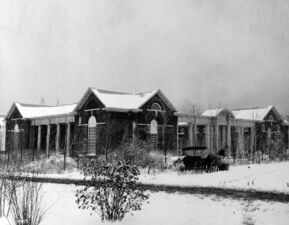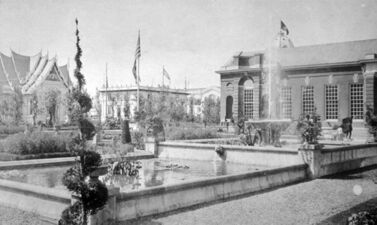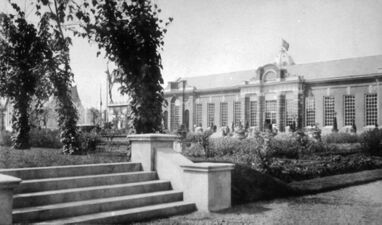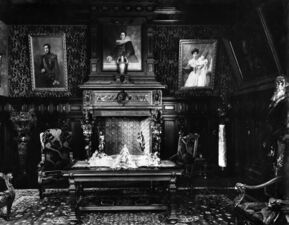Great Britain: Difference between revisions
(Created page with "{{short description|Great Britain National Pavilion}} {{Infobox prepared food | name = Great Britain National Pavilion | image = Great Britain National Pavilion.jpg | image_size = 300px | caption = Great Britain National Pavilion | alternate_name = | country = | creator = | course = | cost = | admission = | profit = | owner = | main_ingredient = | variati...") |
No edit summary |
||
| (4 intermediate revisions by one other user not shown) | |||
| Line 1: | Line 1: | ||
{{short description|Great Britain National Pavilion}} | {{short description|Great Britain National Pavilion}} | ||
{{Infobox | {{Infobox FairBuilding | ||
| name = Great Britain National Pavilion | | name = Great Britain National Pavilion | ||
| image = Great Britain National Pavilion.jpg | | image = Great Britain National Pavilion.jpg | ||
| image_size = | | image_alt = | ||
| image_size = 400px | |||
| caption = Great Britain National Pavilion | | caption = Great Britain National Pavilion | ||
| alternate_name = | | alternate_name = | ||
| | | location = [[Place of Nations]] | ||
| | | no_buildings = 1 | ||
| | | construction_cost= | ||
| | | furnishing_cost = | ||
| profit = | | profit = | ||
| owner = | | owner = | ||
| | | architect = Earnest, George & Yeates | ||
| | | dimensions = 171' x 32' | ||
| | | adult_entry = | ||
| child_entry = | |||
| opening_day = | |||
| dedication_day = May 26, 1904 | |||
| special_day = | |||
| other = | | other = | ||
}} | }} | ||
Great Britain's [[ | Great Britain's pavilion in the [[Place of Nations]] was a reproduction of `The Orangey,' in Kensington Gardens, London, where Queen Victoria was born. | ||
==Description== | ==Description== | ||
The structure was an ideal representation of the Queen Anne style of architecture which was reproduced in a setting of an old English garden | The structure was an ideal representation of the Queen Anne style of architecture which was reproduced in a setting of an old English garden. | ||
The Great Britain Pavilion was larger than the original with the addition of wings that extended back at both ends. | The Great Britain Pavilion was larger than the original with the addition of wings that extended back at both ends. | ||
| Line 37: | Line 39: | ||
==After the Fair== | ==After the Fair== | ||
After the Fair closed, Washington University used the structure as their Art School. It was later torn down and replaced with a modern building. Yet some of the original fireplaces remain. | After the Fair closed, Washington University used the structure as their Art School. It was later torn down and replaced with a modern building. Yet some of the original fireplaces remain. | ||
==Gallery== | |||
<gallery | class="center" | mode=packed-hover | widths=150px heights=150px>> | |||
File:Great Britain-Snow.jpg | Great Britain building April 1904. | |||
File:Great Britain-Garden1.jpg | Garden | |||
File:Great Britain-Garden2.jpg | Garden | |||
File:Great Britain-Interior.jpg | Interior Room | |||
</gallery> | |||
==See also== | ==See also== | ||
| Line 47: | Line 57: | ||
[[Category: | [[Category:Place of Nations]] | ||
Latest revision as of 21:14, 9 January 2024
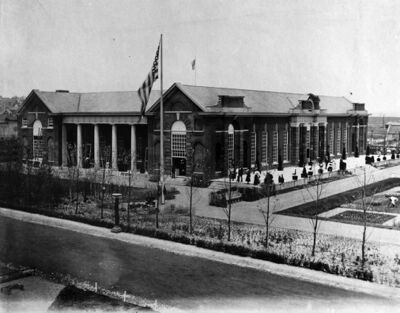 | |
| Location | Place of Nations |
|---|---|
| No. of Buildings | 1 |
| Dates | |
| Dedication Day | May 26, 1904 |
| Architecture | |
| Architect | Earnest, George & Yeates |
| Dimensions | 171' x 32' |
Great Britain's pavilion in the Place of Nations was a reproduction of `The Orangey,' in Kensington Gardens, London, where Queen Victoria was born.
Description[edit | edit source]
The structure was an ideal representation of the Queen Anne style of architecture which was reproduced in a setting of an old English garden.
The Great Britain Pavilion was larger than the original with the addition of wings that extended back at both ends.
Inside, the rooms were filled with originals and copies of old furniture, arms and decorations from the time of Queen Elizabeth, Queen Anne and King George, as well as a room fitted with modern furnishings.
Overlooking the Queen Anne room was an life-sized oval portrait of King Edward the VII in a decoratively carved frame.
Outside, the garden area was enhanced by prominent hedges that gave borders to the distinctly English gardens, showcasing hollyhocks and roses. Junipers and yews, and other shrubs, were arranged into topiaries to resemble the forms of lions, peacocks and other animals.
After the Fair[edit | edit source]
After the Fair closed, Washington University used the structure as their Art School. It was later torn down and replaced with a modern building. Yet some of the original fireplaces remain.
Gallery[edit | edit source]
-
Great Britain building April 1904.
-
Garden
-
Garden
-
Interior Room
